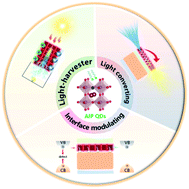All-inorganic perovskite quantum dots as light-harvesting, interfacial, and light-converting layers toward solar cells
Abstract
Solution-processed colloidal lead halide perovskite quantum dots (QDs) are considered one of the promising candidates for next-generation photovoltaics (PVs) due to the excellent optoelectronic properties and low-cost synthetic process. In particular, all-inorganic perovskite (AIP) QDs exhibit better prospects due to their better stability. Although remarkable breakthroughs have been made in bulk perovskite solar cells (SCs), the AIP QD-based SCs (AIPQDSCs) are still on their way to catch up. A lot of reports have summarized the development of perovskite SCs, but few have focused on AIPQDSCs. In this review, we focus on the latest development of AIPQDSCs, and analyze the current bottlenecks they are facing. Also, various optimization means have been discussed to improve the performance of AIPQDSCs from two perspectives of QD materials and device structure, including compositional regulation, surface engineering, interface engineering, and optimization of the carrier transport layer. In addition, AIP QDs as converter for SCs are also presented. Since the stability of perovskite SCs is currently the most pressing issue, the device stability is also highlighted. In the end, a brief summary and perspectives are presented to look forward to the future development of AIPQDSCs.

- This article is part of the themed collection: Journal of Materials Chemistry A Emerging Investigators


 Please wait while we load your content...
Please wait while we load your content...